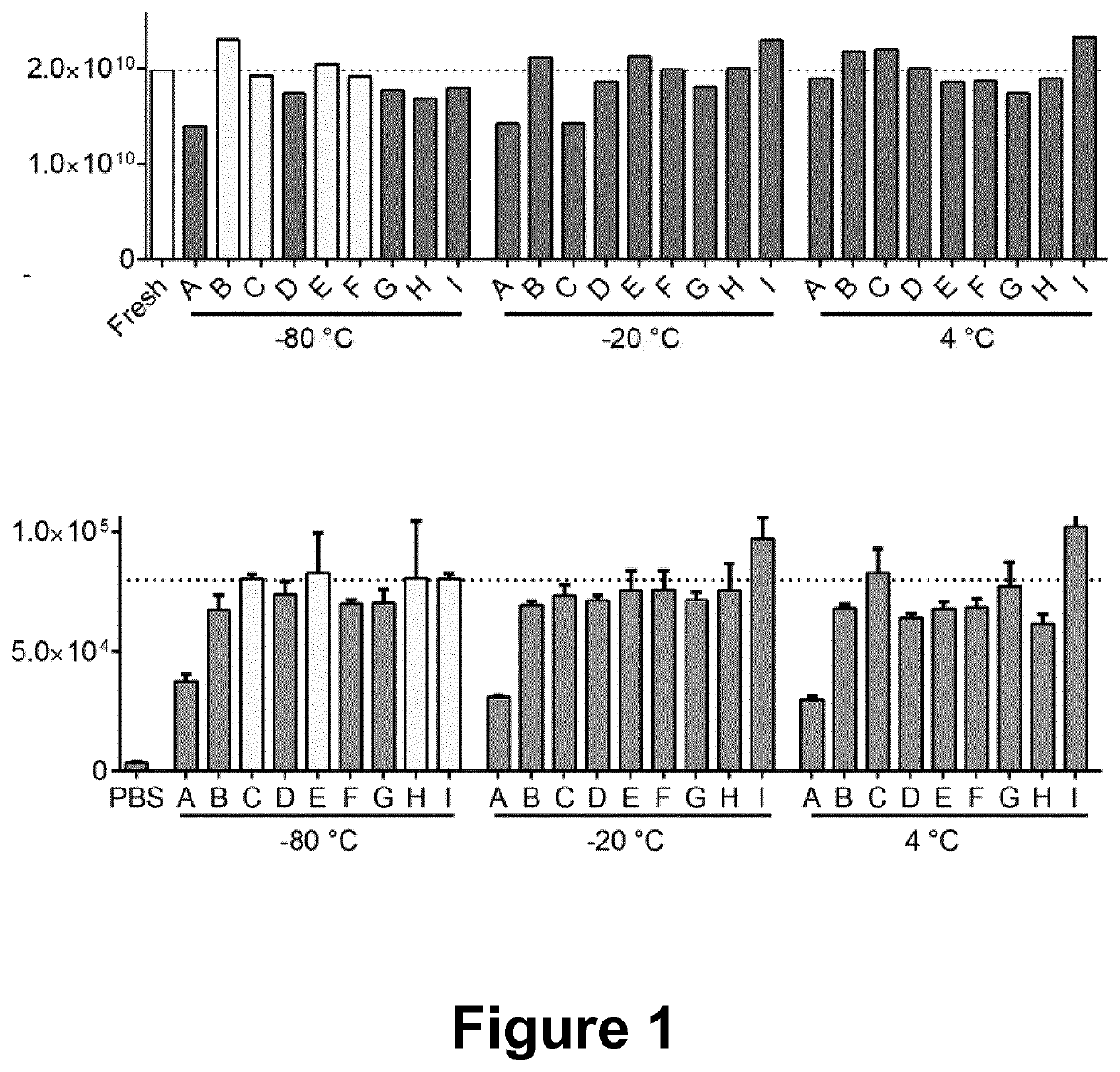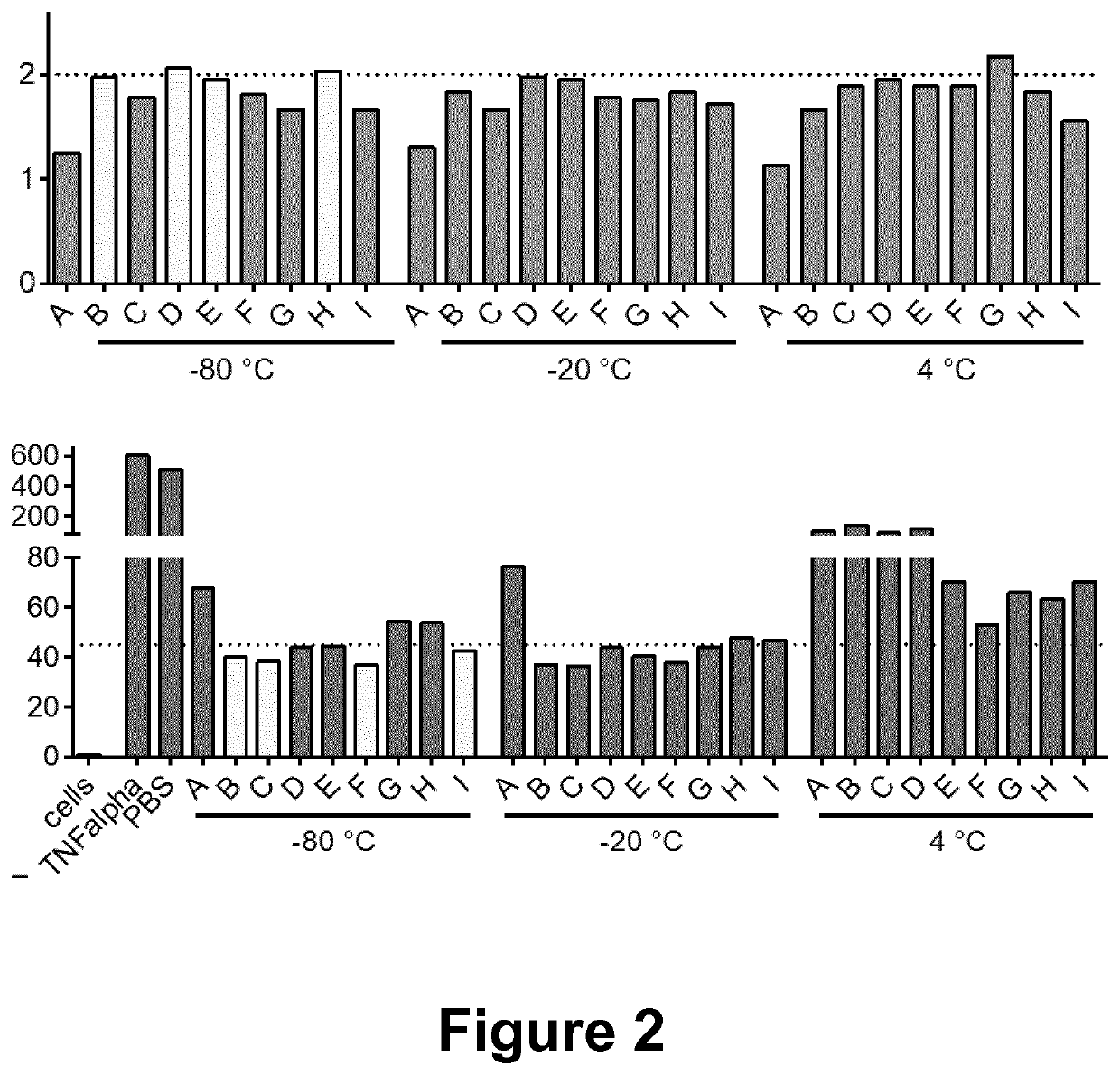Compositions for extracellular vesicle storage and formulation
a technology of extracellular vesicles and buffers, which is applied in the field of compositions for formulating non-native evs for clinical use, can solve the problems of inability to reproduce the method and composition of storing non-native evs, lack of optimal conditions, and inability to achieve long-term storage of maintained stability and activity, etc., to achieve stability, integrity, and without any negative effects on ev function and/or activity
- Summary
- Abstract
- Description
- Claims
- Application Information
AI Technical Summary
Benefits of technology
Problems solved by technology
Method used
Image
Examples
experiment 1
f Engineered EV Stability
[0036]Genetically engineered and immortalized mesenchymal stromal cells (MSCs) were cultured in bioreactors. Conditioned media (CM) containing the EVs was harvested from the bioreactors. To isolate the EVs the CM was centrifuged, first at 500×g for 5 minutes to remove cells, followed by 2,000×g for 10 minutes to remove cell debris and thereafter filtrated through an 0.22 μm filter to remove any larger particles. The filtered CM was then run through a hollow fiber filter using a tangential flow filtration (TFF) system and concentrated down after diafiltration. The pre-concentrated CM was subsequently run through onto BE-SEC columns connected to a chromatography system and concentrated a cut-off spin-filter. The EVs were then stored in different buffer conditions (A-I, see table 1 below) at different temperatures (−80° C., −20° C., 4° C.). After 26 weeks storage, the EVs were thawed and the concentration of the EVs were assessed by nanoparticle tracking analys...
example 2
n of Engineered EV Protein Stability During Storage
[0037]HEK293T cells stably engineered to express a GFP chimeric peptide fused to the common EV sorting protein CD63 (CD63-GFP, resulting in GFP display inside the modified EVs) were cultured in bioreactors. Conditioned media (CM) containing the EVs was harvested from the bioreactors. To isolate the EVs the engineered CM was centrifuged, first at 500×g for 5 minutes to remove cells, followed by 2,000×g for 10 minutes to remove cell debris and thereafter filtrated through an 0.22 μm filter to remove any larger particles. The filtered CM was then run through a hollow fiber filter using a tangential flow filtration (TFF) system and concentrated down after diafiltration with PBS. The pre-concentrated CM was subsequently run through onto BE-SEC columns connected to a chromatography system and concentrated using cut-off spin-filter. The GFP-positive EVs were then stored in different buffer conditions (A-I, see table 1 below) at different t...
example 3
Uptake of EVs as Readout for Retained EV Functionality
[0038]HEK293T cells stably expressing a GFP chimeric peptide fused to the common EV sorting proteins CD63 or Lamp2B (CD63-GFP, resulting in GFP display inside EVs, and Lamp2b-GFP, resulting in GFP display on the outside of EVs) were cultured in bioreactors. Conditioned media (CM) containing the EVs was harvested from the bioreactors. To isolate the EVs the CM was centrifuged, first at 500×g for 5 minutes to remove cells, followed by 2,000×g for 10 minutes to remove cell debris and thereafter filtrated through an 0.22 μm filter to remove any larger particles. The filtered CM was then run through a 300 Kd hollow fiber filter using a tangential flow filtration (TFF) system and concentrated down to approx. 40-50 mL after diafiltration with PBS. The pre-concentrated CM was subsequently run through onto BE-SEC columns connected to a chromatography system and concentrated using a 10 kDa molecular weight cut-off spin-filter. The GFP-posi...
PUM
| Property | Measurement | Unit |
|---|---|---|
| Temperature | aaaaa | aaaaa |
| Temperature | aaaaa | aaaaa |
| Temperature | aaaaa | aaaaa |
Abstract
Description
Claims
Application Information
 Login to View More
Login to View More - R&D
- Intellectual Property
- Life Sciences
- Materials
- Tech Scout
- Unparalleled Data Quality
- Higher Quality Content
- 60% Fewer Hallucinations
Browse by: Latest US Patents, China's latest patents, Technical Efficacy Thesaurus, Application Domain, Technology Topic, Popular Technical Reports.
© 2025 PatSnap. All rights reserved.Legal|Privacy policy|Modern Slavery Act Transparency Statement|Sitemap|About US| Contact US: help@patsnap.com


